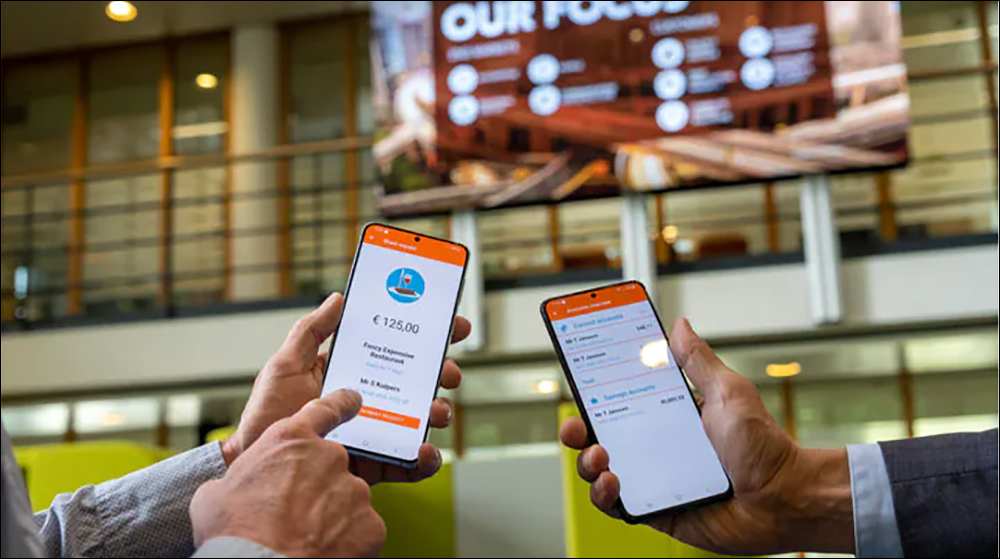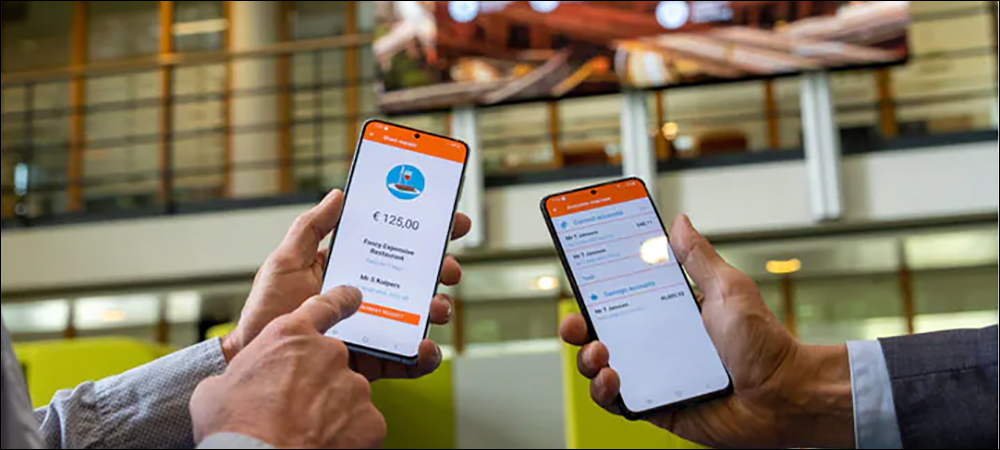Ultra-wideband (UWB) technology may be delivering a new way to conduct contactless payments, as ING Bank pilots a peer-to-peer payment solution enabling individuals to transfer money from their own account to that of a colleague, friend or family member via their smartphones. Unlike Near Field Communication (NFC)-based systems that require a close-contact “tap,” the solution enables the transfer of funds when two phones are a few meters apart, as long as the process is approved in an app.
ING Bank teamed up with NXP Semiconductors to develop and test the UWB-based payment system, known as Project NEAR. Pilot participants comprise ING Bank account holders in the Netherlands, using the Project NEAR app and the UWB functionality in their phones to transfer funds from one account to another. Once the pilot is complete, the bank hopes to expand the solution to other regions and customer bases.
NXP has been helping ING Bank develop the solution, which works for those who have Samsung Galaxy phones, says Dimitri Warnez, NXP’s senior director of UWB mobile and Internet of Things (IoT). The financial company’s ING Factory department built the application and worked with Galaxy smartphones that employ NXP’s Trimension SR100T UWB chip. The UWB payment system offers an alternative to the passive 13.56 MHz NFC-based tapping of a phone against another phone or a payment terminal, or to using cellular-based payment apps that require additional steps.
The goal, Warnez says, is to provide “a better user experience in conducting peer-to-peer payments.” Existing peer-to-peer payments require some effort by participants to send money between bank accounts or credit cards. Apps often require users to search out a profile for the recipient of their funds, using a username or e-mail address to properly identify that person. NFC payments only operate within the very close range enabled at a point-of-sale counter, or if users tap their phones. ING Bank sought a solution that would allow payments at a relative distance, with users simply pointing their phones, selecting an individual displayed for them, and then approving the transaction.

NXP is collaborating with ING Bank and Samsung to pilot a UWB-based peer-to-peer payment application.
How the System Works
The app requires that bank account holders initially set up the system by inputting data that links their account to their phone, after which they can conduct transactions. A typical use case involves sharing a restaurant bill among multiple friends or family members. If two individuals are sharing the cost of a bill, both would open their app. A customer looking to transfer funds would point their phone toward that of another program participant and then initiate the payment, triggering the recipient to receive the payment.
The phone’s ultra-wideband chip transmits to and receives responses from participating phones. Once the app detects a UWB response from another phone within the vicinity, it displays that individual’s ID number. If there is more than one response, a list of individuals is made available from which the user can select. The payer then approves a payment transfer to the person of their choice, and that data is forwarded to the bank. The recipient is prompted to approve the payment, after which the transaction is completed.
The entire process should take only a matter of seconds, Warnez says, and can be conducted across a restaurant table. Field testing is underway among select ING Bank customers and will continue during the latter half of 2022, after which the bank expects to expand the program, depending on the early results of the initial testing.
UWB Use in Smartphones Expands

Dimitri Warnez
At present, not all smartphones come with integrated ultra-wideband chips. The Galaxy Note 20 Ultra and the S21 Ultra are among those with UWB functionality, as are Apple iPhones in the 11 series and later. UWB technology in the phones is predominantly being used for locating objects with the help of smart tags, such as Apple’s AirTag, which comes with a UWB chip to respond to iPhone inquiries. In that way, phone users can locate missing items by following an arrow that points in the direction of a tagged object, such as a set of keys.
UWB technology in phones is being used for indoor navigation and is also being built into automotive access systems to provide a wireless option for hands-free car access via cell phone. When UWB is used in a car-access system, for instance, the angle and distance of transmission between a phone and a car lock can be identified. The system can prompt the car lock to release if the driver is close to the door, and it can activate the engine to start if the phone is detected inside the vehicle. Several automotive key fobs have integrated NFC, Bluetooth and UWB technologies for redundant solutions, while some new cars come with apps for phone-based access via UWB or NFC.
An Alternative to Standard Wireless Payments
In developing the Project NEAR application, ING Bank and NXP worked on security features to ensure that a phone’s UWB component could pinpoint the exact location of another phone based on the angle and distance of that phone’s responding chip. Oher wireless technologies, such as Bluetooth, would not be as precise when it comes to detection location, Warnez says, adding, “The main reason to use UWB is not only knowing how far the device is from another phone, but also exactly where it is.”
The benefits of offering UWB financial transactions are twofold, Warnez explains. In the near term, he says, the goal is to achieve better peer-to-peer payment experiences. “We do see this as a first step in the adoption of UWB in more retail payment in general,” he states. The next step is to include UWB payment opportunities for in-store point-of-sale payments.
NFC technology is expected to continue as the best option in some payment systems, Warnez says, while UWB enables actions such as transfers in a restaurant that spare individuals from having to cross a table. Although UWB can transmit at a distance, financial transactions could be dialed to a much closer range, determined by what the bank would allow. “This is not designed for a transaction across a crowded room,” Warnez states. Project NEAR, he says, “is an interesting first step in using UWB in a payment ecosystem.”
Key Takeaways:
- The UWB system is being piloted in the Netherlands for Project NEAR, enabling consumers to make payments at short distances, such as across a restaurant table.
- The ING Bank and NXP pilot may launch more financial transaction solutions using UWB technology’s highly precise location detection.


